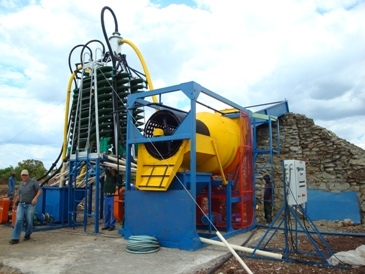With over 30 of its RG scrubber plants installed in Africa, modular mining plant manufacturer Appropriate Process Technologies (APT) is continuing to develop its RG range of rubble scrubbers. “We are consistently supplying complete modular process plants in the 6-t/h to 20-t/h feed rate range but market trends have shown that there is a gap available for 80-t/h plants of the same nature. With this in mind, we have developed the RG500 scrubbing plant, which is being put through its paces right now, at an undisclosed site, on a trial basis before its launch,” says APT consultant Kevin Woods.
Also eagerly awaited in the scrubber range is the arrival of the RG2500 in the near future. The RG2500 will be capable of processing 250 t/h of feed. APT has also been asked to develop RG scrubber plants with diamond pans and jigs.
The RG scrubbers are a process solution that increases the disintegration of placer and alluvial clays and releases bound minerals, normally for subsequent gravity concentration. The RG scrubbers range was developed specifically to confront and overcome the problem of African clays, which do not respond well to simple trommel scrubbers as used on loose glacial placers in the northern hemisphere.
The RG scrubber can be combined with a number of downstream processing options based on gravity separation that disintegrates the feed to release the valuable components, such as gold, chromite, tantalite, tin, diamonds and gemstones, as well as heavy sands, which are then recovered easily and economically. The combination of the RG60 scrubber with the Knelson MD12 is reported to disintegrate even the most stubborn clays by the autogenous scrubbing action in the drum section, proving suitable for the processing of eluvial and alluvial ores, particularly smaller high-value deposits.
APT recently delivered an RG60 gold plant, coupled with a Gemeni table and Knelson MD12 concentrator, to an Angolan gold project. The plant assisted exploration efforts with real-time visual assessment of gold production from target areas. An RG200 scrubbing plant operating at 20 t/h with a Knelson MD20 concentrator on board was later installed after initial results from the smaller plant proved promising.
“The RG200 plant, in Angola, was assembled and running on site within 24 hours and both machines are meeting the requirements on a daily basis,” adds Woods. The company also installed an RG200 scrubbing plant with a Knelson CD20 and Gemeni table at an alluvial platinum claim, in North Africa, in November 2008.
Other recent installations include RG200 chromite fines plants, on the Great Dyke, in Zimbabwe, feeding up to 20 t/h and recovering about 10% of feed as saleable 51% chromite fines. These particular plants cater for rich eluvial chromite fines found in hot-spot, outwashed plain areas below the Great Dyke ridge. These were supplied with water monitored sluice-feed systems.
Bauxite mine Minas Alumina, in Mozambique, was one of the earliest mines to install an RG200 scrubber with a small vibrating screen, which allows for the separation of clays from saleable material.
“The RG scrubber has revolutionised the mine,” says Minas Alumina mine owner John Meikle. He adds that Minas Alumina won the 2007 Exporter of the Year award, in Mozambique, largely as a result of the RG scrubber.
APT is currently installing an RG200 gold recovery plant at a large mining house, in the Democratic Republic of Congo. The company continues to build a number of scrubbing plants for various applications for the local, regional and global market.
“The RG plants have, in many instances, replaced conventional mining plants with their inherent baggage. The instant payback mining assists projects by ensuring the bottom line is achieved quickly and profitably,” says Woods.
An advantage of the RG scrubbing plant over conventional trommel scrubbers includes its mobility, alleviating the concern of fixed-foundation plants that diminish returns on return load transportation. The RG plant can be translocated once an area has been processed.
“This mobility, coupled with low power input, low carbon impact and a chemical-free process, ensures that miners can set up environmentally friendly production facilities on a same-day basis, as opposed to conventional plants that take weeks and, in most cases, months,” says Woods. He notes that the low energy allows for on-site power generation, freeing the operation from the grid.
The RG scrubbing plants, with multiple additions, can also cater for multifaceted mining approaches. The plants are easy to operate, require simple on-site erection and provide chemical-free recovery.
“Factors such as low capital expense costs, quick start-up, low energy requirements, low operating expenditure costs, a high productivity rate and easy translocation are factors paramount to the success of a venture, and each of these is encompassed within the RG scrubbing concept,” says Woods.
“We have now placed over 30 RG scrubber plants into Africa, and while APT is an African concern, it caters not only for African mining. We are spreading our wings further afield, with orders under way for plants in South America and Indonesia,” concludes Woods.
APT designs scrubber plants that can handle high clay contents and large rock-loads.




